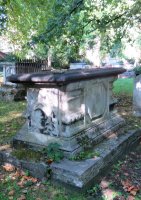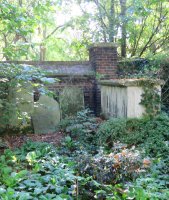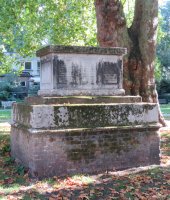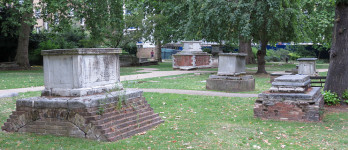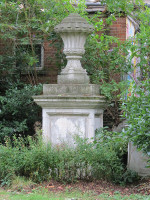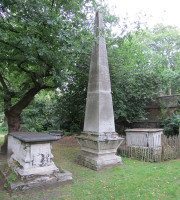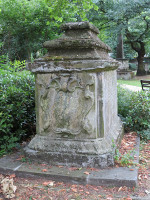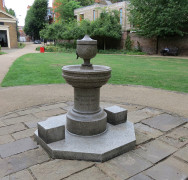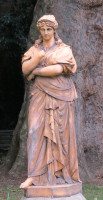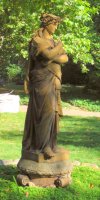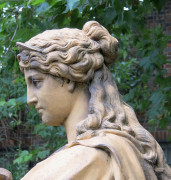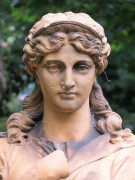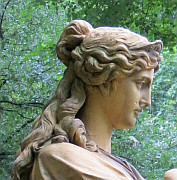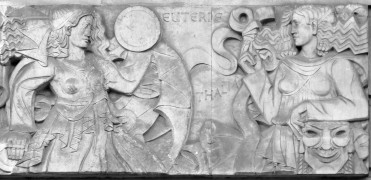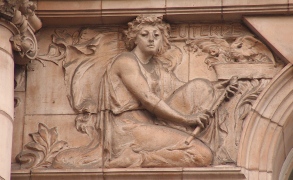Sculptural interest in St George's Gardens, Bloomsbury, London
A few minutes stroll south from St Pancras Station, by Brunswick Square and Mecklenburgh Square, is the easily-missed St George’s Gardens, one-time burial ground for St George the Martyr, Queen Square, and when it was built, St George Bloomsbury – the original wall between the areas reserved for each church is gone, but marked by a line of broken tombstones in the grass. One entrance to the Gardens is at the corner of Wakefield Street and Handel Street, the latter of which leads to Judd Stret and hence to Euston Road more or less opposite St Pancras Station, another entrance leads to Heathcote Street, which emerges in Grays Inn Road, and these are our two convenient ways to come to the Gardens.
Chest tombs in St George's Gardens, 18th and 19th Centuries.
St George’s Gardens took burials from 1715, then, through till 1854/5 when it was closed; it opened as a garden for the public in 1884 (St George’s Bloomsbury bit), with the St George the Martyr portion joining it a few years later. A sign in the Gardens note that it was refurbished by the Heritage Lottery Fund in the late 1990s; they reopened in 2001.
Tombs of Robert Nelson, d.1715, Thomas Falconer obelisk, 1729, and crumbling coat of arms, late 18th C.
There remain the typical lines of gravestones up against the outer walls, rather timeworn (see picture at top of page), and a number of great tomb chests scattered about the lawns in various states of disrepair, a few of which still bear coats of arms and other crumbling carvings. One of the monuments bears a fluted vase of prodigious size, and is the tomb of Robert Nelson, the first person to be buried in the Gardens, in 1715. (He is of interest as one of the original Commissioners of the 1711 Act to build 50 new churches, of which St George’s Bloomsbury was one of the dozen eventually built; another, also by Hawksmoor, was St Mary Woolnoth, which has a page on this site.) Another large chest tomb with outward-angled sides, so actually a casket tomb, forms the base of a tall obelisk, to Thomas Falconer, d.1729. Among those other tombs which can still be read are a number from the early 19th Century.
A small granite drinking fountain in the Gardens is dated 1884, thus from the opening of the first part of the public space. Such things were common - an identical one is in St Andrew's Gardens, a few minutes walk away - if only today's municipal authorities provided such amenities.
Granite drinking fountain, 1884.
Euterpe, by John Broad
Views of Euterpe, by John Broad, in Doulton terra cotta.
Best of all in the grounds is the fine terra cotta statue, from the Apollo and the Muses Tavern which once stood in Tottenham Court Road. She is Euterpe, dates from 1898, and the sculptor was John Broad, working for Doulton's of Lambeth. Somewhat over life-size, rather a majestic and solid figure, she stands with arms as if just unfolded, looking slightly downwards, her long hair over her shoulders and upper back, and finely draped with complex folds around the body and legs. She typifies a particular style of Victorian Classical sculpture, combining the ancient Hellenic mannerisms - the top of the nose joining to the forehead, the angle of the chin, the Classical, calm expression -with Victorian features - those slightly more rounded cheeks, styling of the hair, and softness rather than musculature to the arms.
Euterpe is the Muse of lyric poetry and music, and so it is not surprising to find that another sculpture of Euterpe in London, this time a relief, is over the door of the former building of the London Orchestrial Society in Archer Street (see this page for picture). There is another frieze with Euterpe much closer, in Guilford Street to the south side of Mecklenburgh Square, over the entrance to the The Princess Royal Nurses Home, along with the rest of the Muses, and Hygeia, Goddess of Health. Among other sculpture of Euterpe, I would pick out that on the Clarendon Building in Oxford, and the one in Leicester.
Euterpe with Thalia in Guilford Street, and Euterpe in Leicester.
Exiting to the east takes us through to Gray's Inn Road, and a couple of minutes south along that thoroughfare, past the old frontage of the former Eastman Dental Hospital, leads us to another graveyard turned into a park, with some interesting things: St Andrew's Gardens, Gray's Inn Road.

